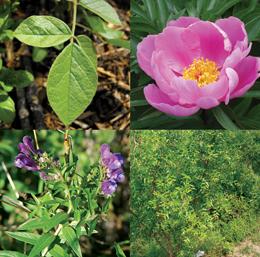An ancient Chinese medicine might ease side effects of cancer treatments.
 Shown (top left to bottom right) are Chinese liquorice, Chinese peony, Skullcap, and the Chinese date tree's fruit, which comprise a Chinese herbal remedy that may ease some of the side-effects of chemotherapy.Wikimedia Commons
Shown (top left to bottom right) are Chinese liquorice, Chinese peony, Skullcap, and the Chinese date tree's fruit, which comprise a Chinese herbal remedy that may ease some of the side-effects of chemotherapy.Wikimedia Commons
An age-old mixture of four herbs could spare patients with cancer some of the side effects of chemotherapy.
The cocktail comprises Chinese peonies, Chinese liquorice, the fruit of the Chinese date tree and flowers of the Chinese skullcap plant. In China, they call it 'Huang Qin Tang' and have used it to treat gastrointestinal problems for about 1,800 years.
A start-up pharmaceutical company called PhytoCeutica has dubbed its proprietary pill of the blend 'PHY906', and shown in early clinical trials that the mix can combat the severe diarrhoea caused by many chemotherapy drugs, which destroy fast-dividing gut cells in addition to tumour cells.
Now, researchers at PhytoCeutica and Yale University School of Medicine, both in New Haven, Connecticut, have some early leads on how PHY906 does this, despite the fact that most of its individual chemical components remain unknown.
PHY906 still needs to prove itself in larger clinical trials. In 2004, the US Food and Drug Administration (FDA) eased regulations on herbal mixtures, allowing the approval of medicines that have been proved to be safe and effective, even if their individual components aren't known.
A green-tea extract produced by the German firm MediGene in Martinsried, and used against genital warts, was the first such medicine to be approved by the FDA under these rules.
"This is a new paradigm of drug development," says Yung-Chi Cheng, a pharmacologist at Yale and head scientific adviser to PhytoCeutica. "It's a typical example of West meets East."
Divide and conquer
The latest results for PHY906, which provide molecular details indicative of how it might repair chemotherapy-damaged guts, could help PhytoCeutica to take its herbal drug down the same road. The results are published online today in Science Translational Medicine1.
When mice receive a dose of the chemotherapy drug irinotecan, which blocks an enzyme, called topoisomerase, that is important to DNA replication, their gut cells begin to die off. However, a dose of PHY906 given with the chemotherapy restored these cells within four days, Cheng's team found. The guts of mice taking the herbal medicine contained fewer dying cells and more dividing cells than those of control animals.
The researchers measured the activity of genes in the gut cells of mice on PHY906 and irinotecan and found that genes in the Wnt pathway, which encourages progenitor cells in the gut to divide, were upregulated.
But ramping up the gut's stem cells isn't the only way that PHY906 combats diarrhoea, Cheng says. Irinotecan also causes inflammation, which the herbal medicine seems to prevent. The guts of mice on PHY906 contained fewer inflammatory immune cells called macrophages than did those of rodents on chemotherapy alone, and the activity of three genes linked to inflammation — Cox2, NF-κB and iNOS — was also down.
Cure concerns
Cheng thinks that PHY906's multitude of effects can be explained through its different chemical constituents, and hopes that his team can identify which chemical is responsible for which change. "This will eventually simplify the procedures used for quality control," he says.
For now, Cheng and his colleagues at PhytoCeutica are using liquid chromatography, mass spectrometry and cell culture to try to establish a chemical and biological fingerprint for PHY906. This approach, he says, will ensure that each batch contains the same active ingredients.
ADVERTISEMENT
"This group seems to have got quality control down to a fine art in terms of the components' activity," says chemical biologist Elaine Holmes of Imperial College London. But, she adds, "the worrying thing is that you're not controlling for toxicity."
Soil chemistry, humidity and even when during the day a plant is harvested affect its chemical make-up, Holmes notes. "I think we have to be cautious with the way we use traditional Chinese medicines and other herbal remedies."
Cheng's team will present phase I/II clinical trial results for PHY906 in patients with pancreatic cancer at a conference in Hong Kong next week. And Cheng hopes to get phase II and III trials going in the United States and Europe soon.
He adds that he would love to account for every last molecule in the medicine; it could even help his team to develop new drugs. However, at this stage, "the importance is for patients undergoing chemotherapy", he says.

No comments:
Post a Comment